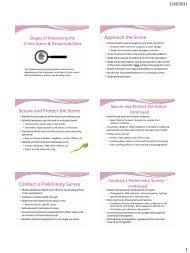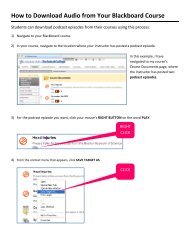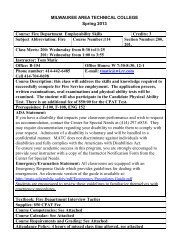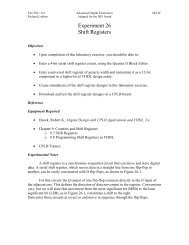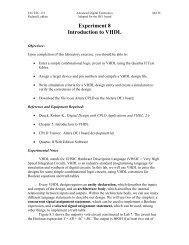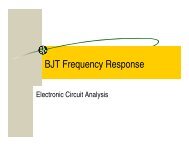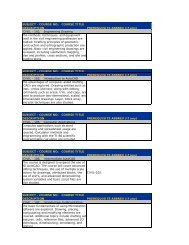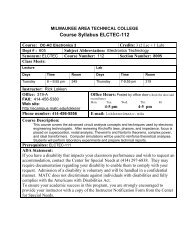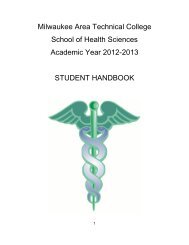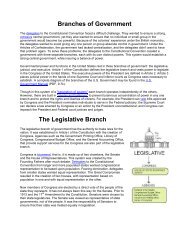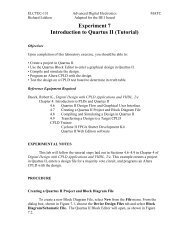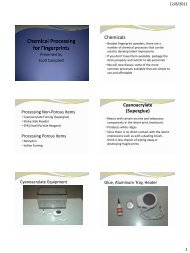WI Forward Award 2012 - Welcome to MATC - Milwaukee Area ...
WI Forward Award 2012 - Welcome to MATC - Milwaukee Area ...
WI Forward Award 2012 - Welcome to MATC - Milwaukee Area ...
Create successful ePaper yourself
Turn your PDF publications into a flip-book with our unique Google optimized e-Paper software.
Measure, Analysis & Knowledge Management: Category 4<br />
Regular HR reports are provided <strong>to</strong> the Board monthly and<br />
quarterly. Term diversity reports track affirmative action relative<br />
<strong>to</strong> college goals (Figures 7-3b and 7-3c). Reports are now<br />
being implemented <strong>to</strong> determine and moni<strong>to</strong>r time-<strong>to</strong>-fill (and<br />
approval-<strong>to</strong>-fill) employment conversion rates through the use<br />
of HR’s PeopleClick data base and eventual dashboard system.<br />
These will be used by HR leadership, staff processors, and<br />
recruiters <strong>to</strong> gauge staff performance. Two HR staff are formally<br />
designated as data sources: Coordina<strong>to</strong>r - HR Information<br />
Systems (headcount, demographics, recruitment) and<br />
Coordina<strong>to</strong>r - Compensation and Analysis (salary and benefits).<br />
Progress on the strategic plan involves mid-year and year-end<br />
(third quarter) reporting for evaluating planning progress, with<br />
KPIs reviewed and updated annually <strong>to</strong> gauge project progress<br />
with strategic goals and objectives.<br />
4.1.c(1) Performance Improvement & Best-Practice Sharing<br />
The college reporting structure allows for the ability <strong>to</strong> hear<br />
about key findings and <strong>to</strong> explore ways <strong>to</strong> employ them when<br />
organizational best practices are uncovered. For example, a<br />
retention project under the Student Success Core Committee<br />
with positive results among Native American students in FY2010<br />
was referenced as a fac<strong>to</strong>r in improved results at a monthly<br />
2011District Board meeting and with minutes posted online. This<br />
led <strong>to</strong> exploration of a similar project in the School of Business<br />
in 2011-12. Best Practices from projects and initiatives are also<br />
shared via the President’s monthly Communiqué and the new<br />
“Open House” for faculty and staff held on Convocation Days.<br />
4.1.c(2) Future Performance<br />
Future performance is targeted for different areas of the college.<br />
These include future FTE enrollment projections and budget<br />
projections, two interrelated processes. Each process is based on<br />
specific assumptions. For example, the FTE projection process<br />
at <strong>MATC</strong> assumes the overriding influence of unemployment<br />
and demographic rates and federal and state policy changes as<br />
key external fac<strong>to</strong>rs and operational and programmatic changes<br />
as key internal fac<strong>to</strong>rs. Projections involve (1) annual statistical<br />
modeling based on the 10 previous years of unemployment<br />
and demographic figures, (2) assessment by academic deans,<br />
based on the previous three years of departmental FTEs and<br />
their awareness of future internal developments; (3) statewide<br />
trends within the WTCS among district colleges, and (4)<br />
assessments by the CFO, based partly on the budget model being<br />
developed for the upcoming year. Past performance in making<br />
projections is tracked by the percentage-variance between actual<br />
and projected amounts, and key fac<strong>to</strong>rs causing considerable<br />
variance are taken in<strong>to</strong> consideration as corrections for the<br />
following year’s assessment.<br />
The budget process is a multi-year development, and includes<br />
assumptions about revenues, salary expenditures, and operating<br />
expenditures regarding their three-year fiscal impact. Scenarios<br />
are created concerning equalized property values, tuition<br />
increases, FTE projections, state aid decreases, retirements and<br />
deficit spending, among other fac<strong>to</strong>rs. These scenarios vary in<br />
their assumptions regarding these fac<strong>to</strong>rs and are carefully vetted<br />
through full District Board, budget development meetings, and<br />
SPBSC meetings. As the fac<strong>to</strong>rs are operationalized with known<br />
data, a specific scenario with its underlying assumptions is judged<br />
the most reasonable basis for budgeting over the three year period,<br />
as well as for the next fiscal year. As fac<strong>to</strong>rs change, the budget<br />
assumptions may change, which affects budget adjustments.<br />
Monthly budget variance reports looking at updated operating<br />
results are moni<strong>to</strong>red and are shared with the District Board,<br />
college leadership, and the SPBSC. These feed the multi-year<br />
assessments, causing adjustments <strong>to</strong> the assumptions and process.<br />
4.1.c(3) Continuous Improvement & Innovation<br />
Innovation results from various sources. The strategic planning<br />
process involves review of annual committee initiatives (Figure<br />
2-1c). The performance of each project partially determines<br />
if projects are rolled over <strong>to</strong> the following year, moved <strong>to</strong><br />
implementation by an area champion, or retired. The review<br />
process each summer also includes an assessment of new<br />
institutional needs, based on input from the president, EVP/<br />
provost, and core committee co-chairs. Innovation is also<br />
informed by national initiatives, independent reports of the<br />
college’s organizational effectiveness, and the dashboard results<br />
presented <strong>to</strong> the District Board. These resources make their<br />
way in<strong>to</strong> the succeeding year’s strategic plan. Other sources<br />
of innovation are found in planning meetings at the cabinet,<br />
divisional, program and departmental levels, which spawn task<br />
forces and ad hoc working committees charged with analyzing<br />
issues and opportunities, and making formal recommendations<br />
for change. Their work is often integrated in<strong>to</strong> a future annual<br />
strategic plan.<br />
Priorities and opportunities are deployed by <strong>MATC</strong> staff<br />
through planning meetings at various college levels. For<br />
example, the merger of the college’s Food Service Operations<br />
with the Baking, Culinary Arts, and Food and Beverage<br />
academic programs was the result of many interdivisional<br />
meetings of the Performance Excellence Committee, which drew<br />
feedback from the EVP/Provost, the President’s Cabinet, the<br />
involved departments, and student government in FY2011. This<br />
culminated in a set of recommendations sent <strong>to</strong> the president<br />
and EVP/provost. Opportunities <strong>to</strong> support instruction while<br />
optimizing cost savings led <strong>to</strong> a clarification of personnel roles, a<br />
market analysis <strong>to</strong> determine student consumer preferences, the<br />
hiring of a Food and Beverage Manager who developed a master<br />
facilities and operations plan, and the hiring of an executive<br />
chef. To accommodate the merger, space needs for production,<br />
equipment, staging and s<strong>to</strong>rage were determined and plans were<br />
drawn up for the integrated operation of the merged entities.<br />
As part of the planning process, the committee reviewed best<br />
industry practices and developed a financially sustainable model.<br />
Planning for a new Advising Center has gone through similar<br />
vetting steps <strong>to</strong>ward implementation.<br />
When appropriate, priorities and opportunities are also<br />
deployed <strong>to</strong> feeder schools and/or suppliers and partners.<br />
Periodic analyses of district high schools by IRSP provide a<br />
scorecard of their prospects applying, testing and registering<br />
at <strong>MATC</strong> for fall terms. Rates are aggregated in<strong>to</strong> quartiles<br />
<strong>to</strong> create a strategic and targeted recruitment plan for the<br />
institution and <strong>to</strong> provide individual high school principals with<br />
performance indica<strong>to</strong>rs. A fall meeting with district principals<br />
orients them <strong>to</strong> college resources as well as <strong>to</strong> highlight and<br />
discuss the findings.<br />
23



